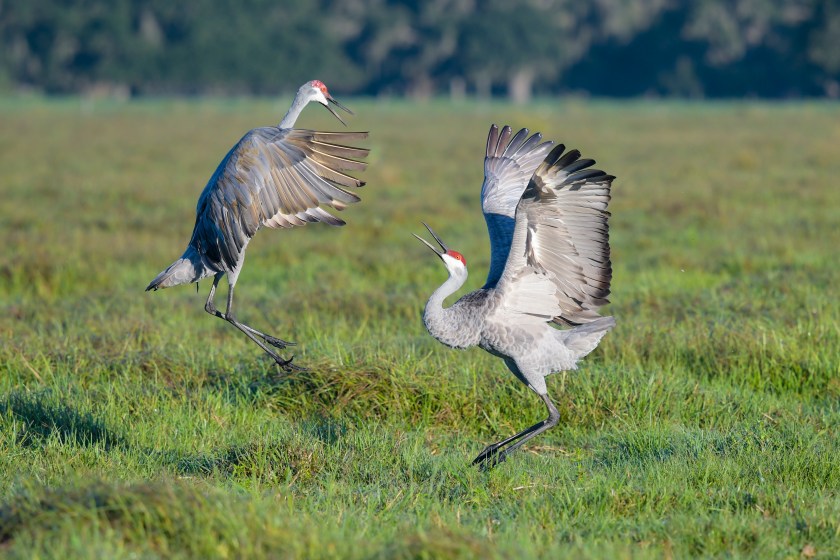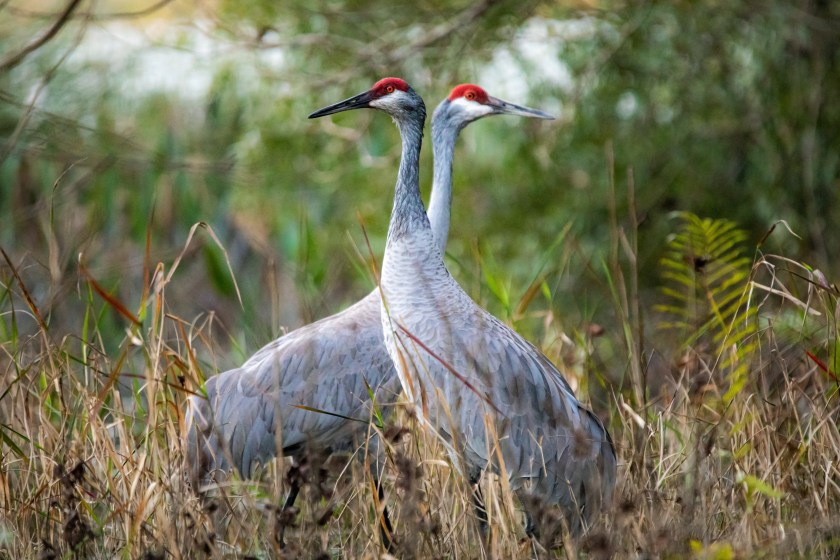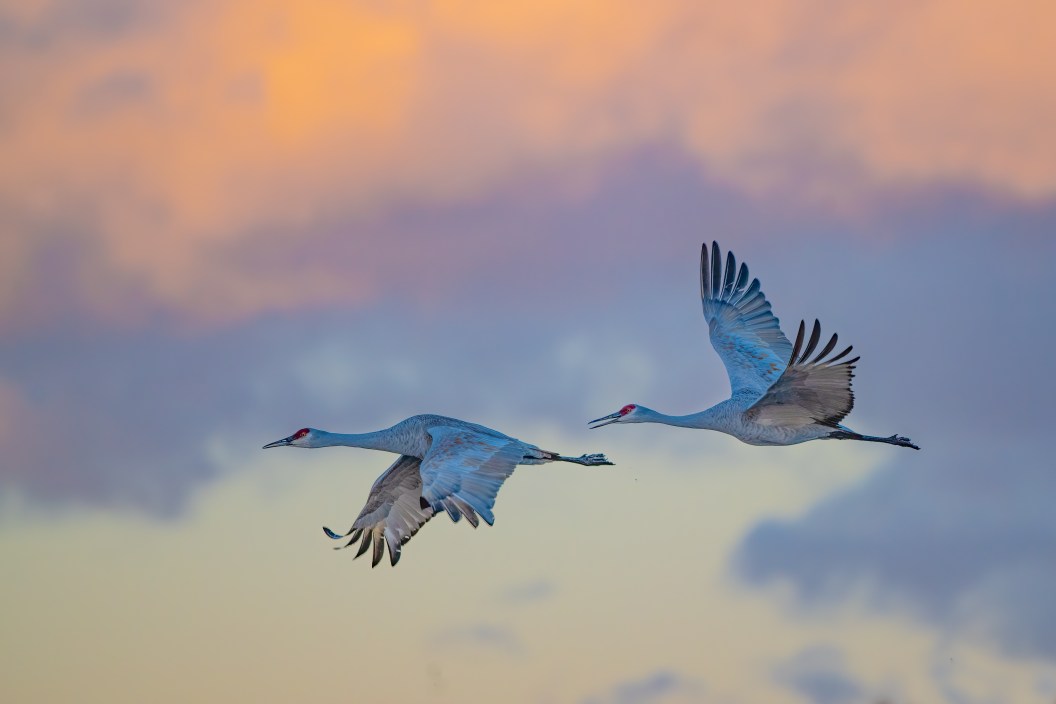A few years ago while exploring logging roads in the Upper Peninsula of Michigan, I came upon a flock of massive birds with long legs and red heads. I couldn't believe their size, some reaching an incredible four feet in height. As I inched ahead to see them closer up, the sandhill cranes took off, revealing their exquisite wingspan as they disappeared over the horizon.
Sandhill cranes are one of the oldest and largest bird species in North America, having been around for at least two million years. By 1900, these birds were almost hunted to extinction—yet they have bounced back. Thanks to conservation efforts, they are one of the few crane species not currently threatened with extinction. This means many states in America have once again legalized the hunting of these birds. Another way to experience them is to visit one of a handful of sandhill crane festivals, which take place across the country throughout the year, following the birds' great migration.
Unlike herons, these large cranes often travel in large flocks, sometimes number over one million birds. Massive flocks of massive birds is quite a sight to behold. Seeing just one take flight can take your breath away; imagine the thrill of watching hundreds or hundreds of thousands move at once. That's exactly what a crane festival offers.
Where Do These Sandhill Live?
Primarily found in prairies, swamps and marshy tundras, these birds live in southern states such as New Mexico and Texas during the winter. They travel in late winter and spring to the Central United States, and complete their journey north to their breeding grounds in the Midwest by fall.
Can You Hunt Sandhill Cranes?
Yes. Sandhill cranes can be hunted in Colorado, Kansas, Montana, New Mexico, North Dakota, Oklahoma, South Dakota, Texas and Wyoming. (Nebraska is the only Central Flyaway state that does not include a hunting season.) Many of these states require a hunting permit, which can be acquired online via each state's website. The meat of the birds is known to be delicious, and can even be made into a smoked bacon. Read more about hunting sandhill cranes in our guide.
How Big Are These Cranes?

Getty Images, pchoui
Sandhill cranes are notorious for their long legs and wide wingspans. They have a wingspan of five to seven feet and stand between three to four feet tall. Their size makes them gorgeous to watch in the wild, especially while they perform their graceful mating dance. While their wingspans are only slightly larger than great blue herons, these cranes can weigh ten pounds—twice the weight of a great blue heron. Though they weigh less and have a slightly smaller wingspan than the California Condor, we can all agree: That's a big bird!
What Are Sandhill Crane Festivals?
Celebrating one of North America's most majestic birds, sandhill crane festivals take place throughout the year in the United States. These enormous birds create a visual spectacle to admire when they travel their migration pattern and Americans eagerly anticipate their temporary stays with local gatherings and celebrations. These festivals include family-friendly events like photography workshops, educational programs, and most popular, expert-led bird-watching tours, which greatly enhance the experience of seeing these birds with your own eyes.
Our Favorite Sandhill Crane Festivals of 2024
When: March 9 - April 6, 2024 | Reservations: Rowe Sanctuary; (308) 468-5282
One of the largest congregations of sandhill cranes can be found in the central Platte River area of Nebraska, where cranes gather from February through early April. The community celebrates with the annual Audubon's Nebraska Crane Festival at Rowe Sanctuary March 9 to April 6, with events and activities to help you marvel at the natural wonder of this important species. The Rowe Sanctuary is owned and managed by the National Audubon Society, and was established in 1974. The sanctuary includes 2.5 miles of river channels and wet meadows, the perfect habitat for sandhill cranes to live and feed. To enjoy the historic sandhill crane migration, we suggest you make a reservation, as the festival is extremely popular. Reservations for the 2024 sandhill crane season can be made online at their website, or by phone.
When: March 22 - March 24, 2024 | Reservations: Othello Sandhill Crane Festival
The 2024 Othello Sandhill Crane Festival ("Wingtip to Wingtip: A Flourish of Feathers") takes place from March 22 to March 24. This festival is unique as it incorporates many bird specialists such as Randy Hill, Jason Fidorra, Dr. Gary Ivey, and more, who will covering topics ranging from cranes and migration patterns to the impact of the Columbia National Wildlife Refuge. Reservations for the 2024 sandhill crane season can be made online.
When: March 8 to March 10, 2024 | Reservations: Monte Vista Crane Festival; (719) 289-7522
The 41st Annual Monte Vista Crane Festival takes place in the San Luis Valley from March 8 to March 10. Known for its Annual Arts and Nature Fair, this festival features artists and vendors so you can pick up unique handmade treasures to take home and never forget the experience of enjoying not only the birdwatching but talented artists of the Monte Vista community. Reservations for the 2024 sandhill crane season can be made online at their website, or by phone.
When: Mid-October | Info: Michigan Audubon Society
The annual Sandhill Crane Festival in Bellevue, Michigan takes place in mid-October and is said to be one of the largest gatherings of these birds in the Midwest. For more than twenty years, the Michigan Audubon Society has teamed with the Kiwanis Club to put on the festival for the public. In addition to bird-watching excursions, artists and sculptors sell artwork depicting the birds in beautiful paintings and trinkets. Take note, this festival is held in an area that does not have paved roads; you may have to walk a quarter mile on bumpy paths. While the dates for the 2024 festival have not been released, you can keep up to date on the event on the Michigan Audubon Society's website.
When: December 11 - December 15, 2024 | Reservations: Friends of Bosque del Apache
Festival of the Cranes occurs from December 11 to December 15, in the town of San Antonio, New Mexico. Located in the center of the state on the Rio Grande, this festival takes place at the Bosque del Apache National Wildlife Refuge, a 57,331-acre refuge established in 1939. The refuge is a stunning sanctuary where you can watch cranes, geese, and ducks. With a popular Junior Ranger program that teaches youth about the vital stopover site for migrating fowl, this sanctuary has over 30,000 acres specifically designated for wilderness and migrating birds. To book a reservation for the Festival of the Cranes, head to their website.
How to Watch the Sandhill Crane Migration

Getty Images, Gummybone
In the winter, sandhill cranes can be found in the southern US. They tend to spend their days in pastures and wetlands, feeding on berries, small invertebrates and vertebrates. At night, they move towards shallow lakes and rivers. In late spring through the fall, these birds can be found in small bogs and marshes across the Central US and finishing their migration to the Midwest.
The greatest time to watch sandhill cranes takes place in the afternoon and early evening between 5 p.m. and dusk when the sunset creates a stunning backdrop - a perfect moment to capture the flocks on film. The birds become most active in the afternoon as they search for food in the marshy wetlands. Get your boots on and wander into the swamps to see the cranes gather until sundown!
- Binoculars for clear inspection of the incredible sandhill crane wingspan is highly encouraged!
- Boots to stay dry while wandering the wetlands.
- Camera to capture the memories and track individual differences between birds.
- Electronic charger and camera batteries - it is common to leave in the morning and return at dusk so double check your equipment is charged and ready for a full day of adventure.
- Field guide - though you may travel in a group with a guide, it is always helpful to have a map - especially when exploring an area where your phone may lose service.
- Warm jacket and extra pair of socks - since these birds are located near wetlands, be prepared with layers and extra socks in case you find yourself exploring in the marsh.
- Rain gear for those gloomy days - you may get wet, but it's a tiny price to pay for the remarkable journey of witnessing one of America's most incredible creatures!
READ MORE: How to Hunt Sandhill Cranes




